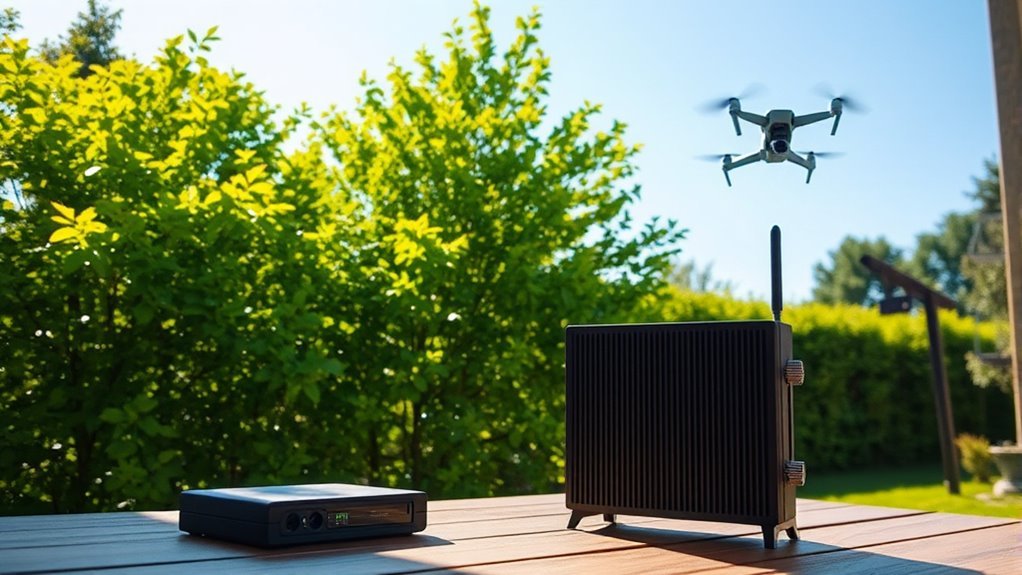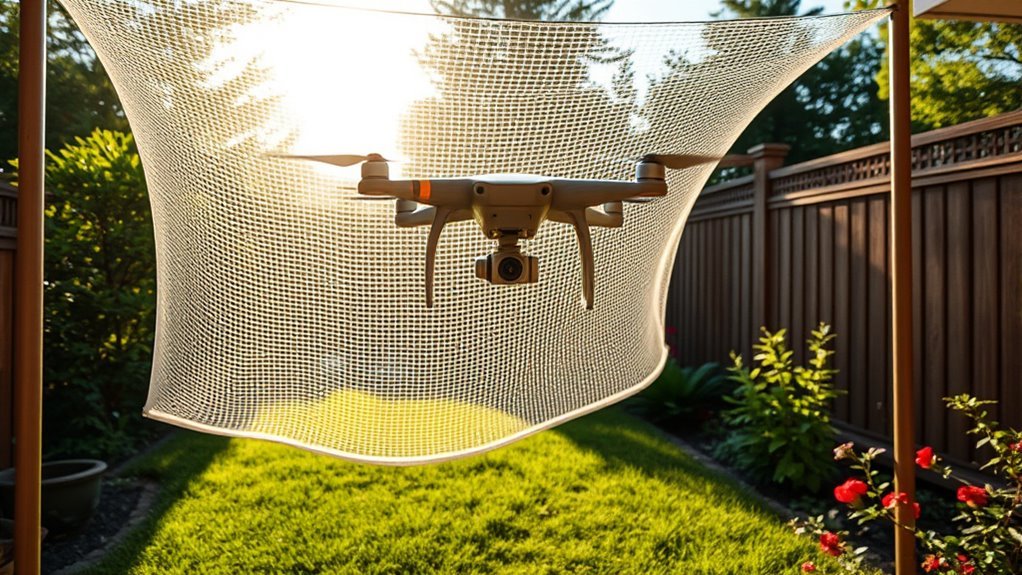You can effectively block intrusive drones by combining signal jammers to disrupt GPS and control links with robust physical barriers like specialized netting. Deploy drone detection systems using radar, RF, and acoustic sensors for early alerts. GPS spoofing can mislead drones by feeding false location data. However, stringent legal regulations govern jammer use, so compliance is critical. Implementing these layered strategies guarantees precise privacy protection while minimizing legal risks. Exploring deeper reveals how to optimize each method effectively.
Understanding How Drones Invade Privacy

Although drones offer numerous benefits, they can also pose significant threats to your privacy by capturing images and data without consent. Drone surveillance operates through high-resolution cameras and sensors, enabling operators to monitor private spaces covertly. This capability facilitates privacy invasion by collecting visual and audio data beyond public scrutiny. You must understand that these drones can effortlessly bypass traditional privacy safeguards, exploiting gaps in regulation and enforcement. Their mobility and discreet operation make unauthorized surveillance difficult to detect and prevent. Recognizing the technical methods drones use for data acquisition empowers you to anticipate potential breaches. By analyzing drone surveillance mechanisms, you can better advocate for effective countermeasures that uphold your rights to freedom and personal security against intrusive monitoring practices.
Using Signal Jammers to Disrupt Drone Communication

When you consider using signal jammers to disrupt drone communication, you must first understand the strict legal restrictions governing their deployment. Different types of jammers—such as GPS spoofers or radio frequency disruptors—vary in effectiveness depending on the drone’s control systems. Evaluating both regulatory compliance and technical capabilities is essential before implementing any jamming solution.
Legal Considerations
Because signal jammers interfere with radio frequencies regulated by federal law, you need to carefully consider the legal ramifications before using them to disrupt drone communication. Violating drone regulations or privacy laws can lead to significant penalties, including fines or criminal charges. Understanding these constraints is essential to protect your rights without overstepping legal boundaries.
| Aspect | Legal Status | Risk Level |
|---|---|---|
| Federal Drone Regulations | Strictly enforced by FAA | High |
| Privacy Laws | Vary by state; protect personal data | Moderate to High |
| Signal Jamming | Generally prohibited without license | Severe penalties |
You must balance your desire for freedom with compliance, ensuring any actions respect established laws and preserve your legal standing.
Effective Jammer Types
Understanding the legal constraints surrounding signal jammers is the first step; next, you need to identify which jammer types can effectively disrupt drone communication within those limits. Primarily, you’ll encounter two categories: GPS jammers and radio frequency (RF) jammers. GPS jammers target the drone’s navigation system by emitting signals that interfere with satellite communication, while RF jammers disrupt the command and control link between the drone and its operator. When evaluating jammer effectiveness, consider the signal range—too short, and the drone remains unaffected; too broad, and you risk illegal interference with unrelated devices. Selecting a jammer with adjustable power output guarantees you maximize disruption within a confined area, preserving your freedom without overstepping legal boundaries. Precision in jammer deployment is vital for maintaining privacy without collateral disruption.
Employing Physical Barriers and Netting Solutions

Although technological countermeasures are often prioritized, employing physical barriers and netting solutions offers a reliable, low-tech method to prevent unauthorized drone access to sensitive areas. You can install robust physical barriers like fences and mesh screens to create a tangible obstacle that drones cannot easily penetrate. Netting solutions are particularly effective when designed with appropriate mesh size and tensile strength, ensuring that drones are physically blocked without hindering your property’s normal use. These barriers provide a passive defense, minimizing reliance on electronic interference and reducing risks of collateral disruption. By integrating physical barriers and netting solutions strategically, you maintain control over your airspace while preserving your freedom from invasive surveillance. This approach complements other tactics, reinforcing your overall drone protection strategy with simplicity and durability.
Installing Drone Detection and Alert Systems
You need to understand the different detection technologies available, such as radar, radio frequency, and acoustic sensors, to effectively identify unauthorized drones. Integrating these detection systems with instant alert mechanisms guarantees you can respond promptly to potential privacy threats. Real-time monitoring not only enhances situational awareness but also provides data for continuous system optimization.
Types of Detection Technologies
Since drones operate using various signals and physical signatures, installing effective detection and alert systems requires a thorough knowledge of the technologies capable of identifying these indicators. You’ll find that infrared sensors detect heat signatures, while acoustic detection captures unique drone sounds. Radar systems track movement, and radio frequency (RF) scanners intercept control signals. Understanding these varied technologies lets you tailor your defense to maintain your privacy without unnecessary restrictions.
| Technology | Function |
|---|---|
| Infrared Sensors | Detect heat from drone motors |
| Acoustic Detection | Identify drone noise patterns |
| Radar Systems | Track physical drone movement |
| RF Scanners | Intercept drone communication |
Choosing the right mix guarantees robust, freedom-respecting drone detection.
Alert System Integration
When integrating drone detection and alert systems, ensuring seamless communication between sensors and notification platforms is crucial for timely responses. You’ll rely on advanced sensor technology—such as radar, radio frequency, and optical sensors—to accurately identify drone presence. Effective alert system integration demands a robust framework that consolidates sensor data, filters false positives, and triggers instant notifications through secure channels. By doing this, you maintain control over your airspace without delay, preserving your privacy and freedom. You must also consider interoperability between different sensor types and alert protocols to create a unified defense mechanism. Proper calibration and regular system testing guarantee reliability. Ultimately, your goal is a streamlined setup where sensor technology and alert systems work cohesively, empowering you to detect and respond swiftly to unauthorized drones infringing on your privacy.
Real-Time Monitoring Benefits
Building on a well-integrated alert system, real-time monitoring offers immediate visibility into unauthorized drone activity, enabling proactive responses before any privacy breach occurs. When you install advanced drone detection and alert systems, you gain access to real time alerts that inform you instantly of potential threats. This immediacy is critical for privacy enhancement, as it allows you to act decisively—whether by deploying countermeasures or notifying authorities. The continuous data stream guarantees no suspicious drone goes unnoticed, preserving your freedom from invasive surveillance. Furthermore, integrating these systems with automated controls reduces human error and response latency. By adopting real-time monitoring, you establish a dynamic, responsive shield that safeguards your privacy efficiently and effectively against evolving drone technologies.
Leveraging GPS Spoofing Techniques
Although drones rely heavily on GPS signals for navigation, you can exploit this dependency by employing GPS spoofing techniques to disrupt their operations. By manipulating GPS signals, you effectively feed false location data to the drone’s receiver, causing it to miscalculate its position or return to a controlled point. Understanding advanced GPS manipulation techniques is essential; these involve generating counterfeit signals that override authentic satellite transmissions. To implement this, you’ll need reliable spoofing software options designed for precision and adaptability, allowing you to tailor signal parameters in real-time. Mastering such tools empowers you to neutralize unauthorized drones while maintaining control over your protected space. This technical approach gives you a decisive edge in safeguarding your privacy without resorting to physical interference.
Legal Considerations and Regulations for Drone Blocking
Mastering GPS spoofing offers a powerful method to disrupt unauthorized drones, but deploying such techniques involves traversing a complex legal landscape. When protecting your drone privacy, you must guarantee full regulatory compliance with federal and local laws, which often prohibit signal interference or drone capture methods without explicit authorization. The Federal Communications Commission (FCC) and Federal Aviation Administration (FAA) strictly regulate radio frequency use and drone operations, respectively. Unauthorized blocking can lead to severe penalties, including fines or criminal charges. It’s vital to understand jurisdiction-specific statutes governing counter-drone measures before implementation. Balancing your right to privacy with adherence to these regulations guarantees your defensive actions remain lawful, preserving your freedom while effectively safeguarding your property from intrusive drones. Always consult legal expertise to align your blocking strategy with current drone privacy laws.
Best Practices for Personal and Property Drone Security
When securing your personal space against unauthorized drones, you need a multi-layered approach combining technology, awareness, and proactive measures. Effective personal security demands not just reactive steps but systematic privacy measures tailored to your environment. Consider these best practices:
- Deploy RF jammers or drone detection systems to identify and disrupt unauthorized drone signals.
- Establish clear physical boundaries with signage indicating restricted airspace to deter casual intrusions.
- Use privacy-enhancing landscaping, such as tall hedges or netting, to limit visual access from drones.
- Stay informed on local drone regulations to report violations promptly and leverage legal protections.

